ជាទូទៅកាលណាគេនិយាយអំពីផ្តែរទ្វារស.វ.ទី៧ គឺគេតែងសំដៅលើរចនាបថសិល្បៈចំនួន២ ពោល គឺរចនាបថសំបូរព្រៃគុក (គ.ស.៦០០-៦៥០) និងរចនាបថព្រៃក្មេង (គ.ស.៦៣៥-៧០០)។ នៅសម័យដំបូងៗ ដូចឃើញនៅតំបន់ប្រាសាទថាឡាបរិវ៉ាត់ ផ្តែរទ្វារភាគច្រើនយើងតែងឃើញមានរូបសត្វមករធំៗនៅសងខាង និងមានក្បាច់ដងធ្នូ (ឥណ្ឌាហៅថា “តោរណ”) កោងចូលគ្នាបង្កើតបានជាចំណុចប្រសព្វនៅចំកណ្តាលមួយ។ តោរណ បែបនេះមានលក្ខណៈដូចនៅស្រុកឥណ្ឌាខ្លាំងណាស់។ ប៉ុន្តែក្រោយមក ក្បាច់តោរណក៏បានវិវឌ្ឍន៍ទៅជារបៀបថ្មីមួយទៀតតាមរបៀបជាសិល្បៈច្នៃប្រឌិតថ្មីនៅក្នុងស្រុក ដោយយើងឃើញមានក្បាច់កំណាត់ដងធ្នូកោងខ្លីៗបង្កើតបានជាចំណុចប្រសព្វចំនួន៣ ដែលក្នុងនោះគេតែងសង្កេតឃើញថា ពេលខ្លះមានរូបព្រះឥន្រ្ទគង់នៅលើដំរីនៅចំកណ្តាល អមដោយរូបទេពជិះសេះ (មរុត) ចំនួនពីរទៀតនៅអមសងខាង។ “ព្រះឥន្រ្ទ” គឺជាស្តេចនៅស្ថានសួគ៌ រីឯ “មរុត” គឺជាទ័ពខ្យល់របស់ព្រះឥន្រ្ទនៅស្ថានសួគ៌។ ផ្តែរទ្វារដែលមានរូបព្រះឥន្រ្ទនៅកណ្តាល អមដោយមរុតនៅសងខាងនេះ គេឃើញមានប្រហែល ៣០ ផ្ទាំង រាយប៉ាយនៅទូទាំងប្រទេសកម្ពុជា និងមាននៅទឹកដីសៀមបច្ចុប្បន្នផង។ តើផ្តែរទ្វារមានរូបព្រះឥន្រ្ទ និងមរុត នៅស.វ.ទី៧ មានអត្ថន័យពាក់ព័ន្ធនឹងនយោបាយរបស់ព្រះមហាក្សត្រនាសម័យនោះយ៉ាងដូចម្តេចខ្លះ?
ប្រសិនបើគិតអំពីព្រះមហាក្សត្រចន្លោះពីគ.ស. ៦០០ ដល់ ៧០០ យ៉ាងហោចណាស់ក៏មានចំនួន ៥អង្គដែរ រួមមាន ព្រះបាទភវវរ្ម័នទី១ ព្រះបាទមហេន្រ្ទវរ្ម័ន ព្រះបាទឦសានវរ្ម័នទី១ ព្រះបាទភវវរ្ម័នទី២ និងព្រះបាទជ័យវរ្ម័នទី១។ ក្នុងចំណោមព្រះមហាក្សត្រទាំង ៥អង្គនេះ ព្រះបាទឦសានវរ្ម័នទី១ និងព្រះបាទជ័យវរ្ម័នទី១ ហាក់មានព្រឹត្តិការណ៍នយោបាយគួរកត់សម្គាល់ច្រើនជាងព្រះមហាក្សត្រអង្គផ្សេងទៀត។ តាមព័ត៌មានអំពីសិលាចារឹកនៅស.វ.ទី៧ យើងតែងឃើញគេច្រើនប្រៀបអំណាចព្រះរាជាដែលជាអ្នកគ្រប់គ្រងនៅរាជធានីឦសានបុរ (សំបូរព្រៃគុក) ប្រដូចទៅនឹងព្រះឥន្រ្ទ ពោល គឺមានន័យថា ស្តេចនៅលើផែនដី ហាក់មានអំណាចខ្លាំងក្លាដូចព្រះឥន្រ្ទដែលជាស្តេចនៅស្ថានសួគ៌ដូច្នោះដែរ។ ជាឧទាហរណ៍ សិលាចារឹកប្រាសាទអុក និងក្លោងទ្វារខាងកើតក្រុមប្រាសាទយាយព័ន្ធ K.440 និង K.442 រៀបរាប់ថា៖ “ព្រះបាទឦសានវរ្ម័នទី១ អន្ទះសាចង់បានស្ថានសួគ៌ និងដំរីរបស់ព្រះឥន្រ្ទ”។ សិលាចារឹកមួយទៀតនៅក្រុមប្រាសាទយាយព័ន្ធដដែល តួប៉ម S17-17 ចុះបញ្ជីលេខ K.604 រៀបរាប់ថា៖ “ព្រះបាទឦសានវរ្ម័នទី១ មានឫទ្ធានុភាពអស្ចារ្យលើសទេពដែលកាន់វជ្រ (ព្រះឥន្រ្ទ) ទៅទៀត”។ រីឯសិលាចារឹកមួយទៀតនៅប្រាសាទស្រីគ្រប់ល័ក្ខណ (សំបូរព្រៃគុក) ចុះបញ្ជីលេខ K.151 ក៏រៀបរាប់ថា៖ “នរសិង្ហគុប្តដែលទំនងជាស្តេចត្រាញ់បម្រើឱ្យព្រះបាទឦសានវរ្ម័នទី១ បានពោលសរសើរព្រះបាទឦសានវរ្ម័នទី១ ជាស្តេចប្រកបដោយគុណធម៌ អង់អាចហានក្លាលើសសត្រូវផងនានា ប្រៀបបាននឹងព្រះឥន្រ្ទដែលជាសេ្តចនៃទេព”។ នៅឆ្ងាយពីតំបន់ឦសានបុរ (សំបូរព្រៃគុក) ក៏មានសិលាចារឹកផ្សេងទៀតដែលរៀបរាប់អំពីស្តេចនិងព្រះឥន្រ្ទដែរ។ ជាក់ស្តែង សិលាចារឹកប្រាសាទត្រៅតាសរ នៅស្រុកបាទី ខេត្តតាកែវ ចុះបញ្ជីលេខ K.709 រៀបរាប់ថា៖ “ព្រះបាទឦសានវរ្ម័នទី១ បានបរិច្ចាកស្រែមួយ គោ ក្របី ៦០ក្បាល ដែលដីខ្លះមានអំណចស្មើនឹងព្រះឥន្រ្ទ”។ ក្រៅពីនេះទៀត គេដឹងថាទីក្រុងមួយរបស់ព្រះបាទជ័យវរ្ម័នទី១ ឈ្មោះថា “បុរន្ទរបុរ” ប្រែថា “ទីក្រុងនៃព្រះឥន្រ្ទ”។ ដោយឡែក សម្រាប់មរុតវិញ មានសិលាចារឹកមួយនៅស.វ.ទី៧ ចុះបញ្ជីលេខ K.81 រកឃើញនៅភ្នំហាន់ជ័យ ខេត្តកំពង់ចាម គេបានប្រៀបប្រដូចព្រះរាជាមានតេជៈបារមី ភ្លឺថ្លា ប្រៀបដូចព្រះកុមារ ដែលដឹកនាំកងទ័ពមរុតនៅស្ថានព្រះឥន្រ្ទ។ ត្រង់ចំណុចនេះ មានន័យថា ចម្លាក់ព្រះឥន្រ្ទ សំដៅទៅលើអ្នកគ្រប់គ្រងនគរ (ព្រះរាជា) រីឯចម្លាក់មរុតសំដៅទៅលើកងយោធា ទឹកដី ឬអ្នកនៅក្រោមអំណាចរបស់ព្រះរាជា។
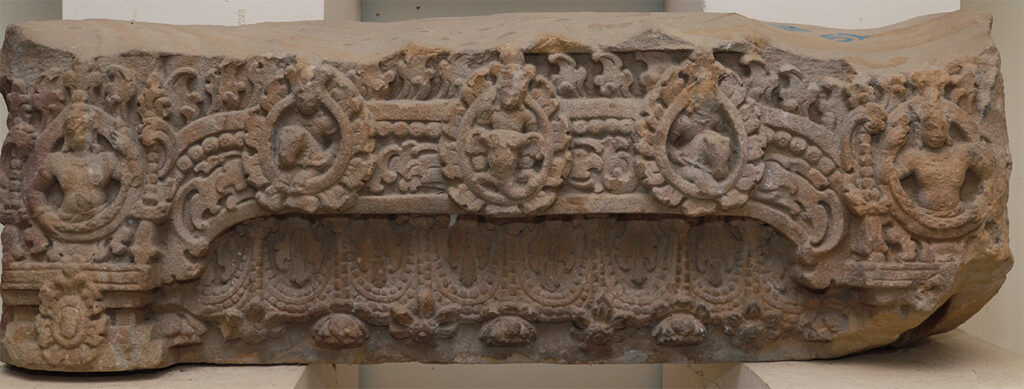
សិលាចារឹកខាងលើជាប្រភពដែលអាចគាំទ្រថា ផ្តែរទ្វារនៅស.វ.ទី៧ ដែលមានរូបចម្លាក់ព្រះឥន្រ្ទគង់នៅលើដំរី អមដោយព្រះមរុតជិះលើសេះ អាចមិនត្រឹមតែជាក្បាច់លម្អរបស់ប្រាសាទ ឬទាក់ទងនឹងគំនិតពិធីសាសនាប៉ុណ្ណោះទេ។ ប៉ុន្តែ លោក Ben Wreyford យល់ថា ចម្លាក់ព្រះឥន្រ្ទ និងមរុត ទំនងដើរតួនាទីជាសិល្បៈក្នុងការផ្សព្វផ្សាយអំណាច និងទឹកដីរបស់ព្រះរាជានៅស.វ.ទី៧ ព្រោះអំណាចរបស់ស្តេចផែនដីគេប្រៀបប្រដូចទៅនឹងអំណាចរបស់ព្រះឥន្រ្ទដែលជាស្តេច នៃទេព។ ដូចមានភស្តុតាងស្រាប់ ផ្តែរទ្វារស.វ.ទី៧រូបព្រះឥន្រ្ទនិងមរុត គេមិនឃើញត្រឹមតែនៅរាជធានីឦសានបុរ (សំបូរព្រៃគុក) ដែលជាតំបន់រដ្ឋបាលសំខាន់របស់ព្រះបាទឦសានវរ្ម័នទី១ ប៉ុណ្ណោះទេ ប៉ុន្តែគេឃើញសាយភាយជាច្រើនកន្លែងនៅទូទាំងប្រទេស។
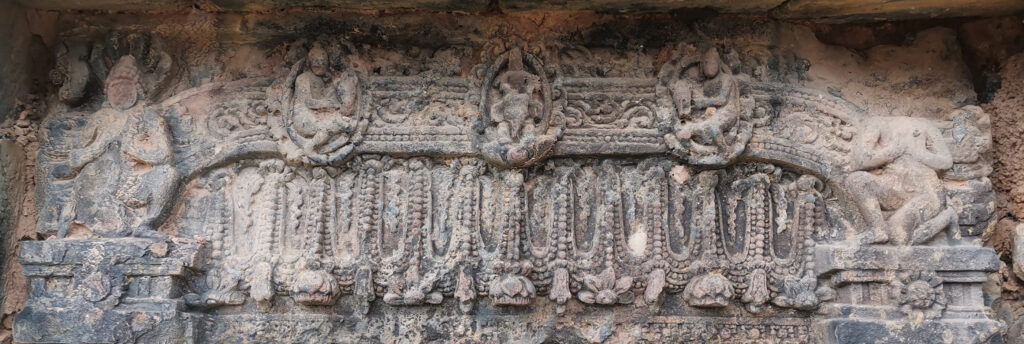
ឧទាហរណ៍ ផ្តែរទ្វារព្រះឥន្រ្ទ និងមរុត ស.វ.ទី៧ រកឃើញនៅទីតាំងបុរាណដ្ឋានជាច្រើននៅខេត្តកំពង់ធំ និងកំពង់ចាម ដែលជាទឹកដីស្ថិតនៅមិនឆ្ងាយពីសំបូរព្រៃគុក ដូចជា ព្រះធាតុរកា វត្តបឹងខាងត្បូង ភ្នំជើងព្រៃ វត្តសូភាស ប្រាសាទដំបងដែក។ល។ តំបន់ទាំងនេះ សុទ្ធសឹងតែជាតំបន់ដែលមានជាប់ទាក់ទងនឹងព្រឹត្តិការណ៍នយោបាយរបស់ព្រះបាទឦសានវរ្ម័នទី១ និងស្តេចក្រោយរាជ្យរបស់ទ្រង់មួយចំនួនទៀត។

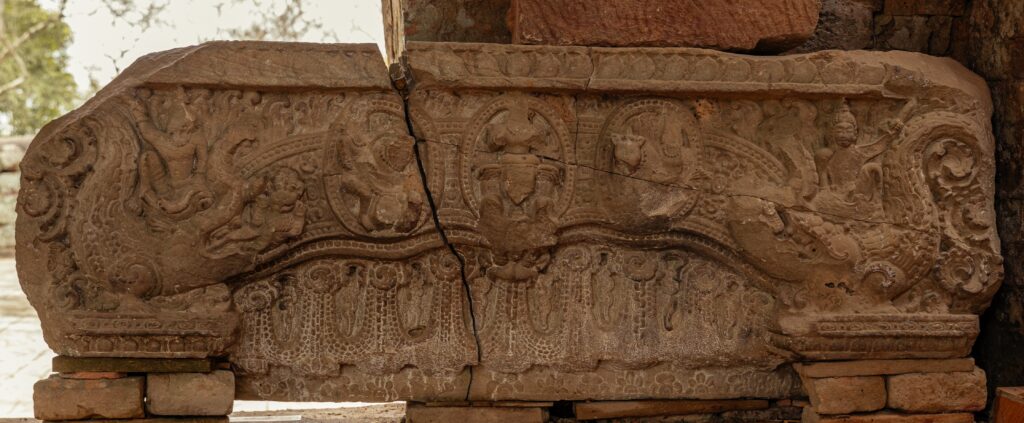
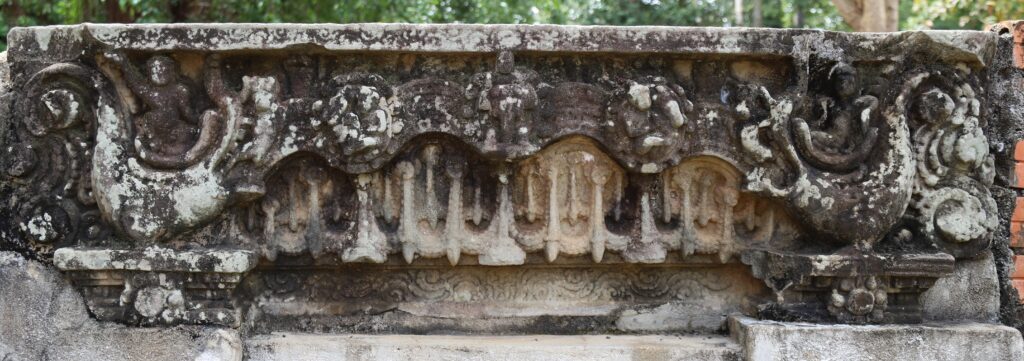
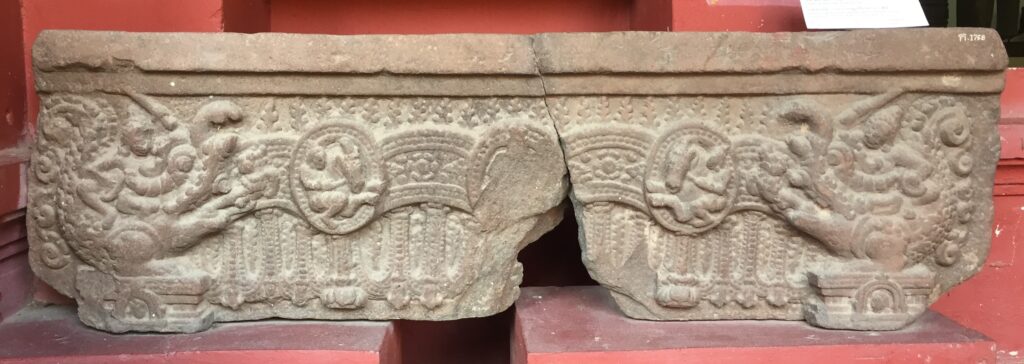
ជាងនេះទៅទៀត ប្រសិនយើងមើលទៅភាគខាងត្បូងប្រទេសវិញ ជាពិសេស ទឹកដីនៅក្បែរៗរាជធានីភ្នំពេញសព្វថ្ងៃ យើងឃើញមានផ្តែរទ្វារមួយចំនួនរចនាឡើងជារូបព្រះឥន្រ្ទគង់នៅលើដំរី អមដោយមរុតជិះលើសេះដូចគ្នា។ ឧទាហរណ៍ ផ្តែរទ្វារវត្តខ្សល់ និងផ្តែរទ្វារវត្តភូមិថ្មី (សព្វថ្ងៃបាត់ទៅហើយ) គេឃើញមានក្បាច់ស្លឹកឈើមានការវិវឌ្ឍន៍ខ្លាំងខុសពីក្បាច់ដែលឃើញនៅរចនាបថសំបូរព្រៃគុក និងព្រៃក្មេង ប៉ុន្តែវាក៏មិនដូចក្បាច់ស្លឹកឈើនៅផ្តែររចនាបថកំពង់ព្រះដូចគ្នា។ ប៉ុន្តែ បើយោងតាមភស្តុតាងជាសិលាចារឹកដែលនៅរកឃើញនៅទីនោះដូចជា K.78 បញ្ជាក់ថា ស្ថិតនៅក្នុងរជ្ជកាលព្រះបាទជ័យវរ្ម័នទី១ នៅក្នុងគ.ស.៦៦៨ និងឆ្នាំ ៦៧៧។
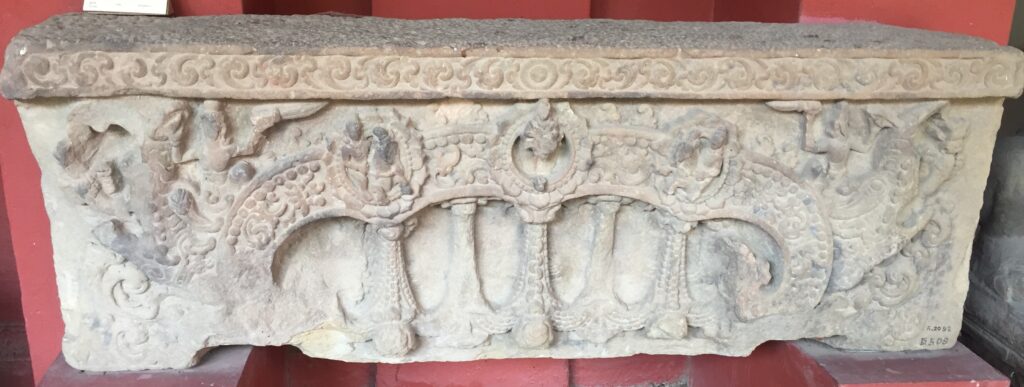
លើសពីនេះទៀត បើយើងហួសឆ្ងាយពីតំបន់ជុំវិញរាជធានីឦសានបុរ និងតំបន់ភាគខាងត្បូង យើងឃើញថានៅស្រុកសៀមបច្ចុប្បន្ន ត្រង់ភូមិសាស្រ្តក្បែរអារញ្ញប្រះថេត (Aranyaprathet) ភាគខាងកើតប្រទេសសៀម ក៏មានផ្តែរទ្វាររចនាបថសំបូរព្រៃគុក ឆ្លាក់រូបព្រះឥន្រ្ទ និងមរុតដែរ ជាក់ស្តែងដូចជា ផ្តែរទ្វារប្រាសាទខៅណយ។ ភូមិសាស្រ្តនេះគេធ្លាប់រកឃើញសិលាចារឹក K.506 ដែលរៀបរាប់ឱ្យដឹងថា នៅគ.ស.ឆ្នាំ៦៣៧ ព្រះបាទឦសានវរ្ម័នទី១ បានតែងតាំងមន្រ្តីម្នាក់ឈ្មោះ “ឦស្វរកុមារ” ជាអភិបាលក្រុងជ្យេស្ថបុរ។ រីឯសិលាចារឹកមួយទៀត រកឃើញនៅទីនោះដដែល ចុះបញ្ជីលេខ K.1150 មានអាយុកាលក្រោយសិលាចារឹក K.506 បន្តិច ក៏បានរៀបរាប់ថា “បុត្រារបស់ព្រះបាទឦសានវរ្ម័នទី១ ព្រះនាម “សិវទត្ត” ត្រូវបានតែងតាំងជាចៅហ្វាយក្រុងថ្មីនៅជ្យេស្ថបុរ។ ពត៌មានសិលាចារឹកទាំងពីរនេះ គឺជាប្រភពដ៏សំខាន់បញ្ជាក់ថា អំណាចព្រះរាជានៅឦសានបុរ មានឥទ្ធិពលធំធេងទៅលើទឹកដីឆ្ងាយពីរាជធានីកណ្តាលរបស់ចេនឡាដែលស្ថិតនៅសំបូរព្រៃគុក ខេត្តកំពង់ធំ។ ក្នុងនោះ ផ្តែរទ្វាររូបព្រះឥន្រ្ទ និងមរុត ដើរតួនាទីសំខាន់ជាសិល្បៈដែលផ្សព្វផ្សាយអំពីអំណាច និងទឹកដីរបស់ព្រះរាជា។

ការយករូបចម្លាក់ព្រះឥន្រ្ទ និងមរុតនៅលើផ្តែរទ្វារ មកពិចារណាពាក់ព័ន្ធជាមួយនយោបាយនេះ វាដូចទៅនឹងការសន្និដ្ឋានរបស់លោក Paul Lavy ដែលយល់ថា រូបព្រះហរិហរ (វិស្ណុ-សិវ) នៅស.វ.ទី៧ ដល់ទី៩ មានមុខងារដើរតួនាទីតំណាងឱ្យភាពជាស្តេច។ លោកយល់បែបនេះដោយហេតុផលថា ការផ្លាស់ប្តូរនយោបាយពីតំបន់ខាងត្បូងមកខាងជើង នាំឱ្យសិទ្ធិផ្លាស់ប្តូរនយោបាយគួរកត់សម្គាល់ ដូច្នេះលោកគិតថា ការប្រើប្រាស់រូបភាពព្រះហរិហរ គឺជាការបង្រួមអំណាចរវាងខាងត្បូងដែលគោរពនិកាយវៃស្ណវ (ព្រះវិស្ណុ ឬហរិ) និងខាងជើងដែលគោរពនិកាយសៃវ (ព្រះសិវ ឬហរ)។
ដូច្នេះជារួមមកផ្តែរទ្វារនៅស.វ.ទី៧ ដែលមានចម្លាក់រូបព្រះឥន្រ្ទគង់នៅលើដំរី អមដោយរូបព្រះមរុតគង់នៅលើសេះ ប្រហែលមិនមែនឆ្លាក់ឡើងដើម្បីតែការលម្អរបស់ប្រាសាទ ឬគំនិតទាក់ទងនឹងសាសនាព្រាហ្មណ៍ប៉ុណ្ណោះទេ តែទំនងអាចបង្កប់ន័យនយោបាយ ក្នុងគំនិតដែលយកសិល្បៈជាយានក្នុងការផ្សព្វផ្សាយអំពីអំណាច និងទឹកដីរបស់អ្នកគ្រប់គ្រងប្រទេសនាស.វ.ទី៧ ជាពិសេស គឺព្រះបាទឦសានវរ្ម័នទី១ និងអ្នកស្នងរាជ្យបន្ទាប់របស់ទ្រង់។ ដូច្នេះ យើងឃើញថា អំណាចរបស់ព្រះបាទឦសានវរ្ម័នទី១ ដែលជាស្តេចសោយរាជ្យនៅរាជធានីឦសានបុរ (សំបូរព្រៃគុក) មានវិសាលភាពអំណាច និងទឹកដីវែងឆ្ងាយពីរាជធានីកណ្តាលខ្លាំងណាស់ មានន័យថា ទៅខាងត្បូងក៏មាន ទៅខាងជើងម្តុំប្រទេសសព្វថ្ងៃក៏មាន៕
——————————–
The political meaning of the lintel in 7th century
This article illustrates the political status in the 7th century through two art styles of lintels namely the Sambor Prei Kuk style (600-650) and the Prei Kmeng style (635-700). These lintels are sometimes showing Indra sitting on an elephant in the middle of the lintel, accompanied by two other deities riding horses (Marut). Otherwise, this article will examine, how the lintel of Indra and Marut in the 7th century is related to the politics of the kings at that time?
If we examine the king between 600 to 700 CE, at least five kings, including Bhavavarman I, Mahendravarman, Isanvarman I, Bhavavarman II, and Jayavarman I. Of these five kings, Isanvarman I and Jayavarman I seem to have the most notable political events. According to inscriptions from the 7th century CE, the power of the king, who ruled Isanapura (Sambo Prei Kuk), was often compared to Indra, meaning that the kings of the earth seemed to have strong power as Indra, the King of Heaven. For example, the inscription of Ouk temple and the eastern gate of the Yeai Poeun temples K.440 and K.442 state: “Isanvarman I was anxious to need Indra’s heavens and elephants.” Another inscription in the same group of Yeai Poeun temples, tower S17-17 in the registration list number K.604, states: “King Isanvarman I was more powerful than the deity who held Vajra (Indra).” Another inscription on the temple of Prasat Srei Krup Leak (Sambor Prei Kuk) registered number K.151, also states: “Narasimhagupta who is likely to be the warlord to serve Isanvarman I, praised Isanvarman I as a virtuous king who was stronger than his enemies, like Indra as the king of gods.” Besides the Isanapura area (Sambor Prei Kuk), there are other inscriptions describing the king and Indra, for instance, the inscription of Trao Ta Sor temple in Bati district, Takeo province registered number K.709, states: “King Isanvarman I donated a rice field, sixty of cows and buffaloes, some lands have the same power as Indra.” In addition, it is known that one of the cities of Jayavarman I was called “Purindrapura” which means “city of Indra”. As for Marut, there is an inscription in the 7th century registered number K.81, found on Han Chey Mountain, Kampong Cham Province. At this point, it means that the statue of Indra refers to the ruler of the kingdom (king), while the statue of Marut refers to the army, territory or subordinates of the king.
The inscription above is a source that can support the lintels in the 7th century, with a sculpture of Indra sitting on an elephant accompanied by Marut riding a horse may not be a temple decoration or related not only to the concept of the ritual. But Mr. Ben Wreyford believed that the sculptures of Indra and Marut were likely to play an artistic role in spreading the power and territory of the kings in the 7th century because the power of the kings of the earth was likened to the power of Indra, the king of gods. As evidenced of the lintels of the 7th century, Indra and Marut were not only found in the Isanapura (Sambor Prei Kuk), the main administrative area of Isanvarman I, but also found in many places entire the country.
For example, the lintel of Indra and Marut 7th century were found in many archeological sites in Kampong Thom and Kampong Cham provinces, such as Preah Theat Roka Temple, Wat Boeng Khang Tbong, Phnom Cheung Prei, Wat Sobheas, Dambang Dek temple, etc. These are all areas associated with the political events of Isanvarman I and some of his later kings.
In addition, we see that in present-day Siam, geographically near Aranyaprathet in eastern Thailand, there are also lintels of Sambor Prei Kuk-style carved with images of Indra and Marut, apparently such as the Khao Noy temple. In this geography, the inscription K.506 is found, which describes that in 637, Isanvarman I appointed an official named “Isvara Kumar” as the governor of Jayensthapura. Another inscription found there registered number K.1150, also states that “the son of Isanvarman I “Sivadat” was appointed the new governor at Jayensthapura. These two inscriptions are important sources confirming that the royal power in Isanapura had great influence over the territory far from the central capital of Chenla, located in Sambor Prei Kuk, Kampong Thom province. In that, the lintels of the image of Indra and Marut play an important role as art that promotes the power and territory of the king.
The consideration of the image of Indra and Marut on the lintel in connection with politics is similar to the conclusion of Mr. Paul Lavy, who perceived the image of Harihara (Vishnu-Shiva) in the 7th to 9th centuries as representing the king. He understood the reason that the political change from the south to the north led to significant political change, so he thought that the use of the image of Harihara was a consolidation of power between the South, who worshiped the Vishnu sect (Vishnu or Hari) and the North, which worships the Shiva sect (Shiva or Hara).
Overall, the lintel in the 7th century with the sculpture of Indra sitting on an elephant, accompanied by the Marut sitting on a horse, may not have been carved just for the decoration of the temple or for ideas related to Brahmanism. But it is likely to have political implications in the idea of using art to spread the power and territory of the rulers of the seventh century, especially Isanvarman I and his successors.
អត្ថបទដោយ៖ លោក ម៉ង់ វ៉ាលី






